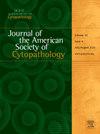将高危人乳头瘤病毒检测与细胞学和活检结果对比,以检测宫颈发育不良,为临床筛查指南提供信息。
Q2 Medicine
Journal of the American Society of Cytopathology
Pub Date : 2025-03-01
DOI:10.1016/j.jasc.2024.11.003
引用次数: 0
摘要
简介:美国预防服务工作组(USPSTF)对宫颈癌筛查的建议包括单独筛查高危人乳头瘤病毒(hrHPV)的选择,但一些研究报道,hrHPV单独检测遗漏了癌前病变和癌性病变。在这项研究中,我们以宫颈细胞学和活检作为比较,评估了hrHPV检测宫颈发育不良的测试性能特征。材料和方法:我们对2019年1月至12月在我们机构进行的Papanicolaou涂片进行了回顾性分析,同时进行了hrHPV和细胞学检测。在实验室信息系统中识别病例,提取的数据包括患者年龄、hrHPV结果、并发细胞学结果和随访宫颈活检结果(如有)。结果:共有3748例患者同时进行hrHPV和细胞学检查,79例患者同时进行hrHPV和活检。敏感性、特异性、阳性预测值(PPV)、阴性预测值(NPV)hrHPV检测细胞学异常增生的比例分别为70% (95% CI: 60.7%-77.8%)、98% (95% CI: 97.4%-98.4%)、53% (95% CI: 46.2%-58.8%)和99% (95% 98.7%-99.2%)(P值结论:hrHPV单独检测将错过细胞学鉴定的30%的异常增生样本和24%的宫颈活检证实的异常增生样本。这些发现支持细胞学和hrHPV检测双重宫颈癌筛查的综合策略。本文章由计算机程序翻译,如有差异,请以英文原文为准。
Benchmarking high-risk human papillomavirus testing against cytology and biopsy results in the detection of cervical dysplasia to inform clinical screening guidelines
Introduction
The United States Preventive Services Task Force (USPSTF) recommendation for cervical cancer screening includes the option to screen with high-risk human papilloma virus (hrHPV) alone, but some studies have reported that hrHPV testing alone missed precancerous and cancerous lesions. In this study, we evaluated the test performance characteristics of hrHPV in detecting cervical dysplasia with cervical cytology and biopsy as comparators.
Materials and methods
We conducted a retrospective analysis of Papanicolaou smears between January and December 2019 performed at our institution with concurrent hrHPV and cytology testing. Cases were identified in the laboratory information system and abstracted data included patient age, hrHPV result, concurrent cytology result, and follow-up cervical biopsy result where available.
Results
A total of 3748 cases were identified with concurrent hrHPV and cytology testing and 79 cases with concurrent hrHPV and biopsy results. The sensitivity, specificity, positive predictive value (PPV), and negative predictive value (NPV) “hrHPV for detecting dysplasia on cytology was 70% (95% CI: 60.7%-77.8%), 98% (95% CI: 97.4%-98.4%), 53% (95% CI: 46.2%-58.8%), and 99% (95% 98.7%-99.2%), respectively (P value <0.00001). The sensitivity, specificity, PPV, and NPV of hrHPV for detecting dysplasia on biopsy was 76% (95% CI: 61.1%-86.7%), 30% (95% CI: 14.7%-49.4%), 64% (95% CI: 57.0%-70.5%), and 43% (95% CI: 46.6%-61.0%), respectively (P value <0.3).
Conclusions
hrHPV testing alone would have missed 30% of dysplastic samples identified by cytology and 24% of dysplastic samples confirmed by cervical biopsy. These findings support a comprehensive strategy of dual cervical cancer screening with cytology and hrHPV testing.
求助全文
通过发布文献求助,成功后即可免费获取论文全文。
去求助
来源期刊

Journal of the American Society of Cytopathology
Medicine-Pathology and Forensic Medicine
CiteScore
4.30
自引率
0.00%
发文量
226
审稿时长
40 days
 求助内容:
求助内容: 应助结果提醒方式:
应助结果提醒方式:


